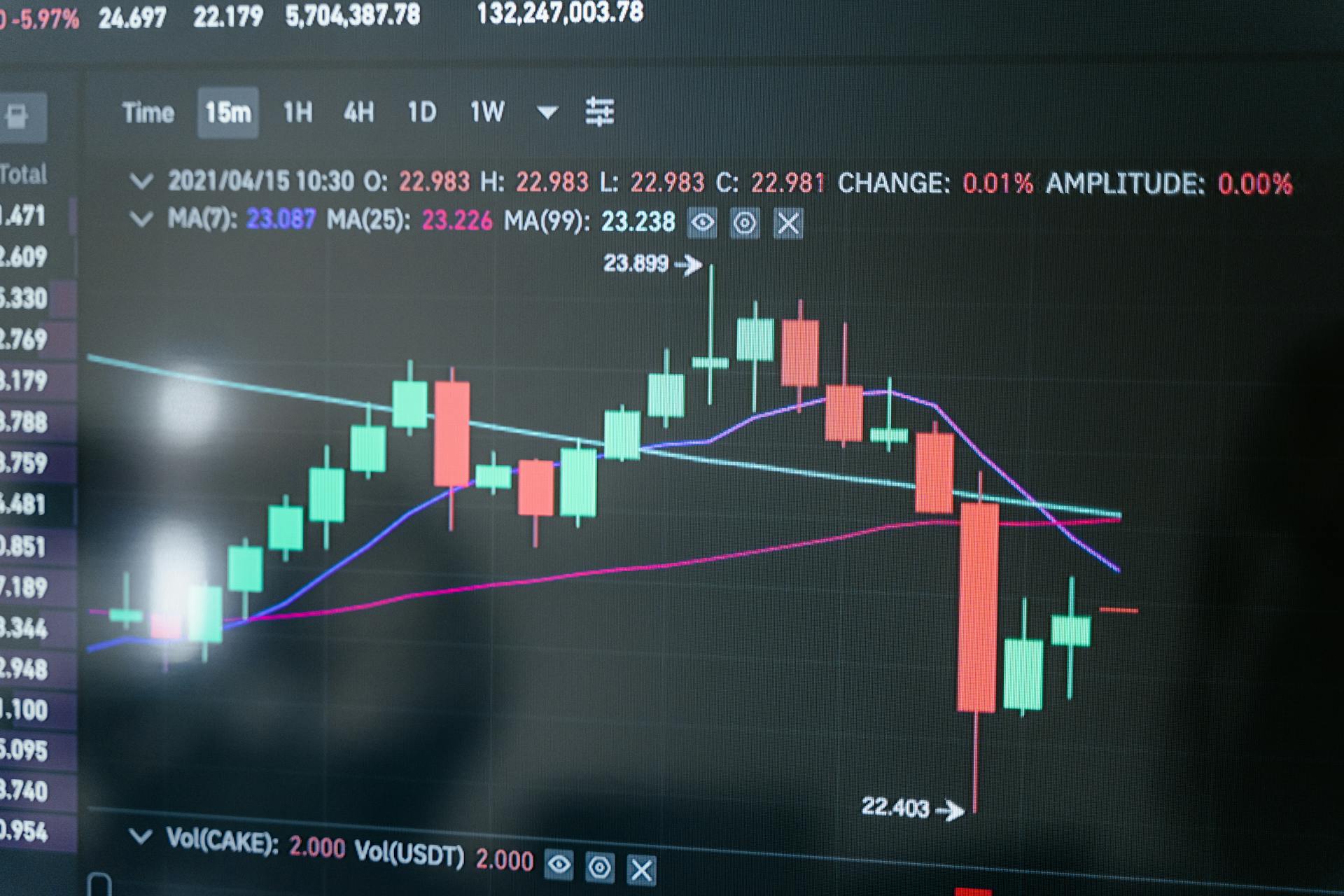
The market sentiment indicator is a powerful tool for traders, offering insights into the collective emotions and attitudes of market participants. It's a gauge of investor sentiment, measuring the degree of optimism or pessimism in the market.
A high market sentiment indicator suggests a strong bullish bias, while a low indicator suggests a bearish bias. This can be a valuable guide for traders, helping them make informed decisions about buying or selling.
The market sentiment indicator can be influenced by various factors, including economic indicators, news events, and market trends. By analyzing these factors, traders can gain a deeper understanding of market sentiment and make more informed trading decisions.
For traders, understanding market sentiment is crucial for making informed decisions about buying or selling.
Worth a look: Basic Indicator Approach
What Is a Market Sentiment Indicator?
A market sentiment indicator is designed to represent how a group feels about the market or economy. These indicators look at how bullish or bearish market actors are and what they are thinking and feeling.

Sentiment indicators attempt to quantify sentiment in the form of figures or graphically to predict how current beliefs and positions may affect future market behavior. This helps forecast investors' future behavior.
Unusually high or low sentiment readings can prompt investors to act in a contrarian way. For example, extremely bearish investors may be a contrary signal that market prices could start heading higher soon.
Types of Sentiment Indicators
Investors can use sentiment indicators to gain insight into the stock market's mood. Extreme readings given by these indicators can indicate impending reversals.
There are various types of sentiment indicators, including those that measure investor attitudes. These indicators can be used to identify potential market shifts.
The most common type of sentiment indicator is the Put-Call Ratio, which compares the number of put options to the number of call options. This ratio can indicate whether investors are bearish or bullish.
Another type of sentiment indicator is the Advance-Decline Line, which measures the number of advancing stocks versus declining stocks. This indicator can help identify market trends.
Investors can also use the VIX Index, which measures market volatility. High readings on the VIX can indicate increased market anxiety.
Sentiment indicators can be used in conjunction with other technical and fundamental analysis tools to make more informed investment decisions.
For more insights, see: Altcoin Season Indicator
Behavioral Finance and Sentiment

Investor biases and emotions play a significant role in shaping investment decisions. Overconfidence can lead to excessive trading, increased risk-taking, and a failure to adequately diversify a portfolio. People may feel overconfident in their position, leading to excessive trading and increased risk-taking.
Investors often react strongly to market downturns or negative news, leading to panic selling and hasty decision-making. Fear can exacerbate market volatility and contribute to self-fulfilling prophecies of downturns.
The herd mentality can lead to groupthink and market bubbles. Investors following the crowd without conducting independent analysis can result in irrational decision-making. The fear of missing out (FOMO) on a profitable trend or the desire to conform to market consensus can result in irrational decision-making.
Contrarian investors intentionally do the opposite of what market sentiment indicators show, deciding to swim upstream from the popular investment choice.
Here's a summary of common emotional factors impacting investment decisions:
- Overconfidence
- Fear
- Herd mentality
Social media and news outlets play an increasingly important role in shaping market sentiment. A tweet from a prominent figure or a viral news story can cause instant market movements. Platforms that use AI to analyze sentiment from news articles and social media posts are becoming more prevalent, allowing investors to track public opinion in real-time.
You might enjoy: Social Finance

The dot-com bubble's unprecedented rise and subsequent collapse is a prime example of how market sentiment can drive markets and investor decisions. The bursting of the dot-com bubble in the early 2000s marked a sobering reality check for investors, with many technology stocks experiencing astronomical gains before plummeting due to a lack of underlying fundamentals.
If this caught your attention, see: Equity Market Bubble
Technical Analysis and Sentiment
Technical analysis and sentiment analysis are two powerful tools that can be combined to create a more comprehensive trading strategy. By analyzing price and volume data, technical indicators can provide insights into market dynamics, while sentiment indicators can offer an additional layer of information by assessing the psychological factors influencing trading decisions.
Technical indicators can be used in conjunction with sentiment indicators to identify potential entry or exit signals. For example, you could look for discrepancies between stock sentiment analysis data and technical indicators like moving averages or RSI (Relative Strength Index). This can help traders confirm existing trends or identify potential trend reversals.
Check this out: Lseg Market Data
Here are some ways to combine technical analysis and sentiment:
- Identify overbought or oversold markets using technical indicators like RSI, and then use sentiment indicators to confirm or contradict the signal.
- Look for divergences between technical indicators and sentiment indicators to identify potential trend reversals.
- Use sentiment indicators to gauge market expectations and potential reactions to major events, and then use technical analysis to identify potential entry or exit points.
By combining technical analysis and sentiment analysis, traders can gain a more complete understanding of market dynamics and make more informed trading decisions.
Technical
Technical analysis is a crucial part of understanding market sentiment. It provides a different perspective on what's happening in the market by manipulating price or volume data.
Technical indicators are formulas that analyze price or volume data to provide insights into market trends. They can be used to confirm existing trends or identify potential trend reversals.
The CBOE Volatility Index (VIX) is a popular technical indicator that measures market fear and uncertainty. A high VIX value indicates a fearful market.
Market momentum and volume are also important technical indicators. High buying volumes in a positive market can indicate an overly greedy or bullish market.
Volatility is another key technical indicator that measures the degree of price movement. Unusual rises in volatility can be a sign of a fearful market.
If this caught your attention, see: Impact Investing Trends
Google Trends data can also be used as a technical indicator to gauge market sentiment. A sudden increase in search volume for certain keywords can indicate a change in market sentiment.
The Sentiment Index is a technical indicator that gauges effective speculative interest in currency pairs and currencies. It can be used as a contrarian indicator to identify potential trading opportunities.
Historical Sentiment Index data can provide valuable insights into how market sentiment has changed over time. It can help traders understand the ebbs and flows of market sentiment and make more informed trading decisions.
Technical indicators can be used in conjunction with sentiment analysis to create a more comprehensive trading strategy. By combining technical indicators with sentiment analysis, traders can gain a deeper understanding of market trends and make more accurate predictions.
Worth a look: Currency Market Trends
NYSE 200-Day MA
The NYSE 200-day Moving Average is a key indicator to watch. It shows how many stocks are trading above their long-term moving average and is expressed as a percentage.
See what others are reading: Market Moving Information
A rising indicator suggests a broad bullish sentiment, and a reading over 60% is a strong sign. If over 80% of stocks are trading above their 200-day moving averages, it may indicate that stocks are overbought.
This indicator can help traders identify potential trend reversals and confirm existing trends. It's a valuable tool for risk management and can help traders make informed decisions.
A reading above 60% is a good sign, but it's essential to keep an eye on the overall market conditions. If the indicator is rising and shows a high percentage, it may be a good time to take a closer look at the market and adjust your trading strategy accordingly.
Suggestion: Stock Trader Almanac
Data Sources and Sentiment
The data sources for the market sentiment indicator are crucial in determining its accuracy. We're gathering data from five sources, each valued equally to the day before to visualize meaningful progress in sentiment change.
The current index is specifically designed for Bitcoin, as a significant part of its volatility comes from the coin's price. This is because Bitcoin's price can fluctuate greatly, making it a key factor in the overall sentiment.
Curious to learn more? Check out: Alternative Data (finance)
The index includes various factors, such as the coin's price, to provide a comprehensive view of the market. By considering these factors, we can gain a deeper understanding of the market's sentiment.
Sentiment indicators can play a significant role in shaping trading strategies by helping traders identify potential trend reversals.
See what others are reading: Market Sentiment and Technical Factors
Commitment of Traders Report
The Commitment of Traders Report is a weekly report that shows the aggregate positioning of different groups of traders in the futures markets. This report can be a valuable tool for traders, as it can indicate a rise in an asset's price when speculative interest is rising.
A rising speculative position in the Commitment of Traders Report can be a sign that an asset's price is likely to rise. This is because speculative traders are betting on a price increase, which can drive the price up.
However, when speculative interest hits an extreme, it can indicate that prices could head the other way. This is a crucial point for traders to consider, as it can help them anticipate potential trend reversals.
By analyzing the Commitment of Traders Report, traders can gain insight into market sentiment and make more informed trading decisions.
Consider reading: Asset Management Ratio
Data Sources
We're gathering data from five key sources to track the sentiment change of the crypto market.
The current index is focused on Bitcoin only, due to its high volatility in coin price.
We're including data from multiple factors in the current index.
These factors are valued the same as the day before to show meaningful progress in sentiment change.
We're planning to offer separate indices for large alt coins in the future.
Each data point is given equal importance to create a comprehensive picture.
Readers also liked: Why Do Share Prices Change
Frequently Asked Questions
Is market sentiment a good indicator?
Market sentiment is a reliable indicator of market direction and momentum, combining both quantitative and qualitative methods to inform trading decisions. By incorporating sentiment analysis, traders can make more informed decisions and stay ahead of market trends.
What is the market sentiment indicator on thinkorswim?
The Market Sentiment indicator on thinkorswim estimates the prevailing market sentiment by comparing recent close prices to historical highs and lows. Higher values may indicate a bullish sentiment, while lower values may suggest a bearish sentiment.
What is the current US stock market sentiment?
The current US stock market sentiment is bearish at 31.43%, slightly higher than last week but still below the long-term average. This indicates a moderate level of pessimism among investors.
Sources
- https://www.investopedia.com/terms/s/sentimentindicator.asp
- https://alternative.me/crypto/fear-and-greed-index/
- https://www.angelone.in/knowledge-center/share-market/what-is-market-sentiment
- https://www.dukascopy.com/swiss/english/marketwatch/sentiment/
- https://www.aimtechnologies.co/market-sentiment-index-a-comprehensive-guide/
Featured Images: pexels.com


